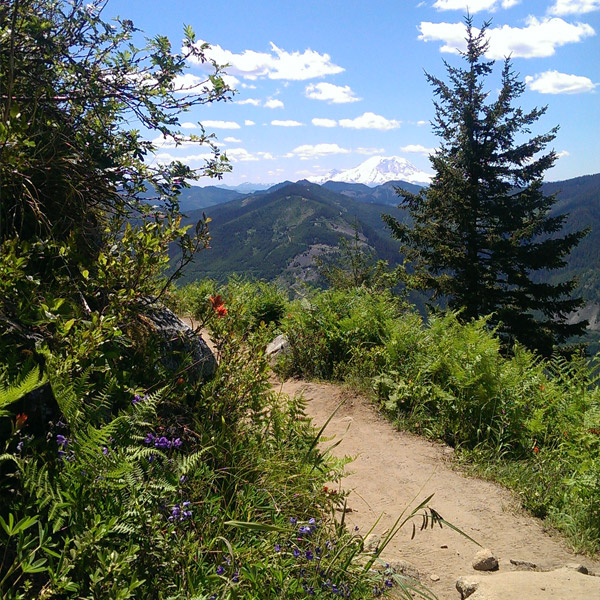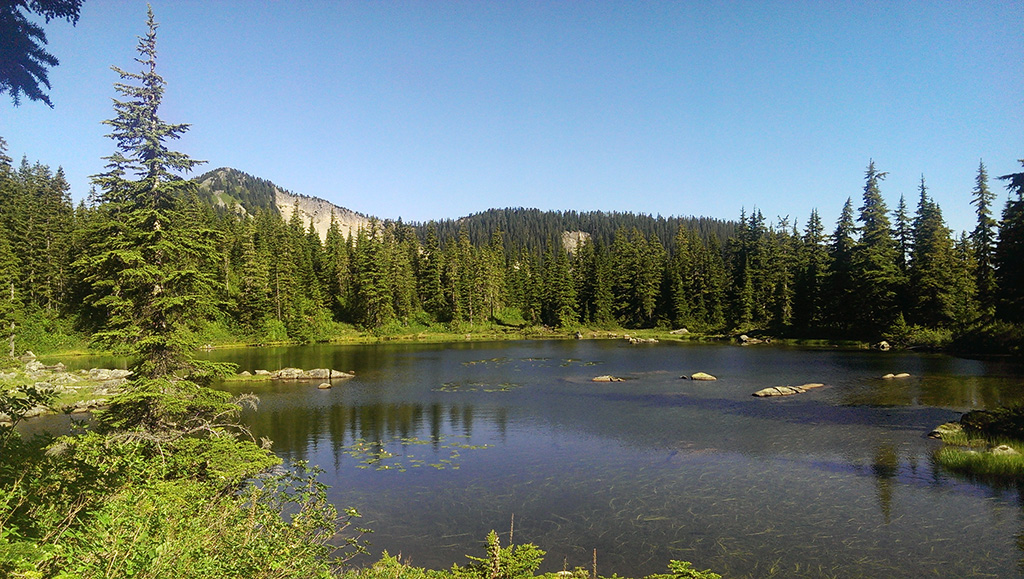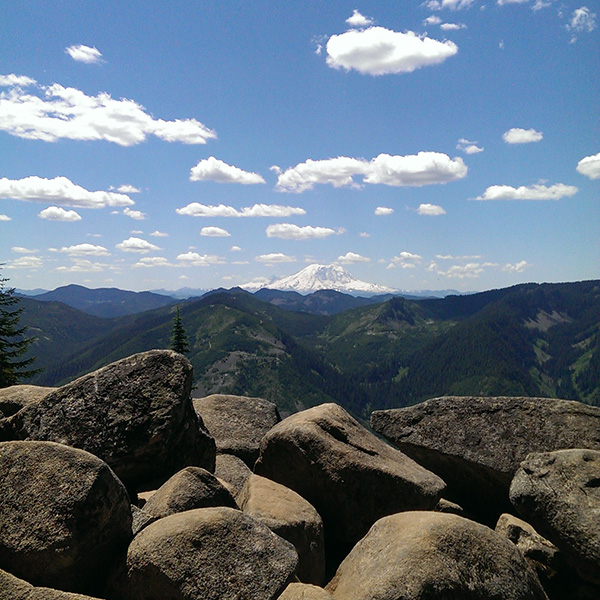For our second backpacking adventure we decided on the lakes off Ira Spring Trail. Named for a noted photographer and conservationist, the trail offers expansive views of Mt Rainier and a choice of lakes to stop at. We had hiked Mason Lake before, so we had a good idea what to expect.
After a couple mile drive up the well-maintained Forest Service road, you reach the Ira Spring trailhead. Due to our garage sale adventure, we arrived late and started our hike just past 1PM. We were aiming for Mason Lake, which is about 3.25 miles in and 2400ft up. The climb begins in a heavily wooded area with an even rise for the first mile. After several switchbacks, you break out to an Alpine meadow and rock slides, which prove slightly more difficult. Wildflowers dot the landscape, providing splashes of color amongst the gray and green.

At three miles, we crested the ridge line and began a gentle descent into the densely forested Mason Lake basin. After half a mile, you reach the water’s edge. Massive boulders surround the trail and line the edge of the lake, silently hinting at the extreme geologic forces that shaped the Cascade range. We found an unoccupied boulder by the lake and sat down for a late lunch of baked chicken legs. Though small and inviting on a warm summer day, Mason Lake is deep and glacier fed, making it supremely cold. Lunch was punctuated by teenagers shrieking in pain after a quick jump in.
Given our late arrival, about 3PM, we weren’t surprised to find most of the campsites already taken. One lone site, set back from the lake, was available. We decided to press on though, curious what Rainbow and Island Lakes had to offer. The first, Rainbow, is barely half a mile on, though we didn’t stop since we were aiming further. After the broad, arrow-straight trail to Mason, the narrow, meandering, and hilly hike was a welcome change. Plus, it was practically deserted.
Mosquito Lake
After a mile, we arrived at the generously named Island Lake. While little more than a shallow pond, it was still a beautiful sight. Lily pads dotted the surface and dragonflies flittered about. The water line looked low (we’re in a drought after all), so the “island” was more a marshy peninsula. With no one else in the area, we claimed a spot just off the water and set up camp.

[quote position=”right”]Dinner was served early at our campsite that evening. Unfortunately, we were the meal.[/quote]
What do you get when you combine a shallow pond, warm water, and an early summer? Yup, mosquitos. I wager we were their first feast of the year. An evening breeze and prodigious amounts of bug spray helped, a bit. Following a dinner of (surprisingly tasty) freeze-dried Mountain House beef stroganoff, we retired to the safety of our tent. The ravenous horde buzzed above our head, just out of reach.
The warm, sunny day led to a typical cold, clear night. This scattered the mosquitoes and brought out the stars. Even with the illumination of a waning moon, it was still a sight to behold. With near total silence, we lay in our tent meditating on the Milky Way majestically stretched out above us. We also spotted several satellites, and even saw the International Space Station transit the night sky.
The cold night also provided an opportunity to test our sleep “system” (because everything in backpacking, from cooking to climbing, is a “system”). I did have a pad, but forgot a long-sleeve shirt so my arms were colder than I’d prefer. My wife, however, suffered through another chilly, sleepless night. For our next trip she’s purchased a balaclava, sleeping bag liner, and high r-rated pad. She’ll also be sleeping with a hot-water filled Nalgine bottle, so she should be nice and toasty.

Morning broke, the temperature rose, the mosquitoes came out, and we broke camp for the hike back. Back at the ridge line, just passed Mason Lake, we were treated to an astonishing view of Mt Rainier. It was an awe-inspiring sight, with cotton candy clouds dotting the sky and the snow-capped peak towering above the Cascades. It was a fitting way to cap a wonderful trip.
More learnings from the trail
With each journey comes new learnings. Here are a few of the latest lessons:
- Tracking details: I’ve started keeping a log of possibly useful data points, such as our starting pack weight, and what time we begin and end a hike. Given our challenges with chilly evenings, I also bought a digital thermometer that tracks the high and low temperatures so we’ll know how cold it gets in the deep of night. Hopefully all of this will help us better plan our future trips.
- Make a list: There are probably 200 individual items we bring with us on each trip, from a change of socks to iodine tablets. The big things (tents, sleeping bags) are hard to forget, but the details (a trash bag, matches) are easy to overlook. So, we created a checklist which we’ll go through when packing to ensure we have everything. We’ll continually revise it, but you can download our first version (PDF).
- “Personal warmth system”: As we get more into backpacking, it is becoming clear that there’s no one thing that will keep you warm at night. While a sleeping bag may be “rated to 20F”, that assumes you have a good pad, proper base layer, and decent tent. On a particularly cold night, you may also need a hat, gloves, and heated water bottle. Needs vary significantly from person to person, so expect some time to figure out what works for you.